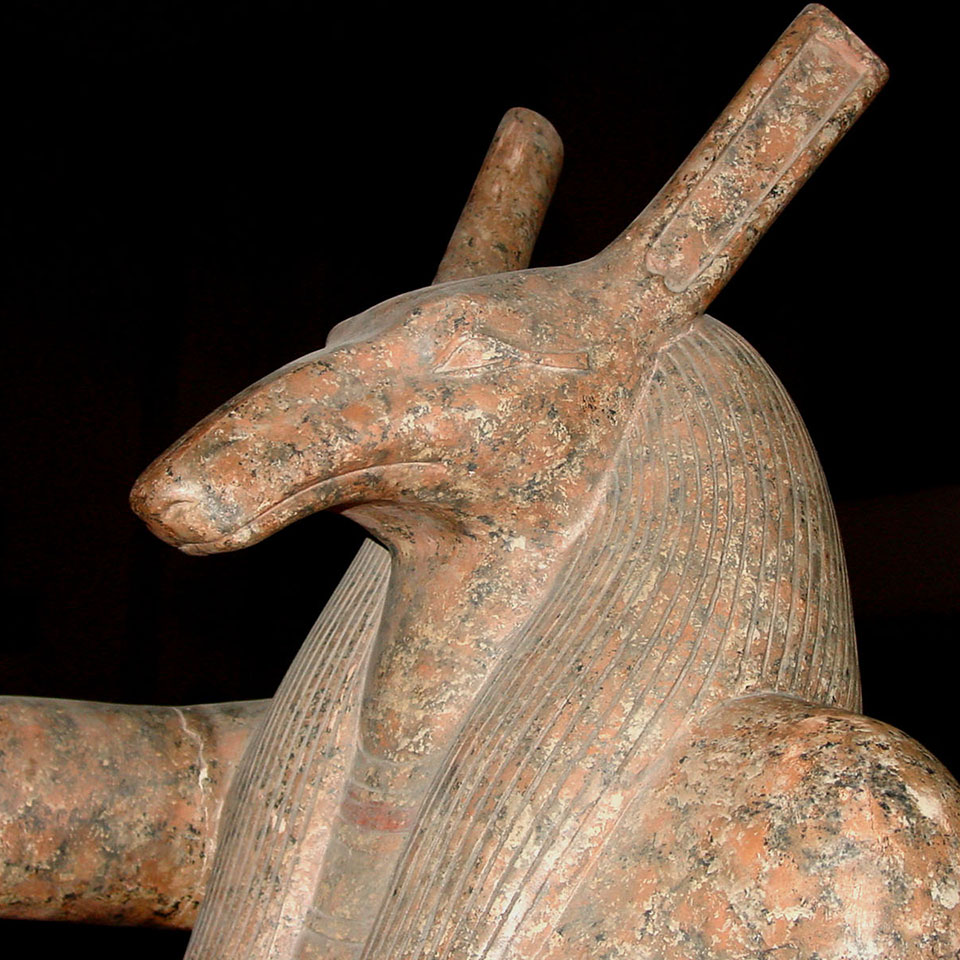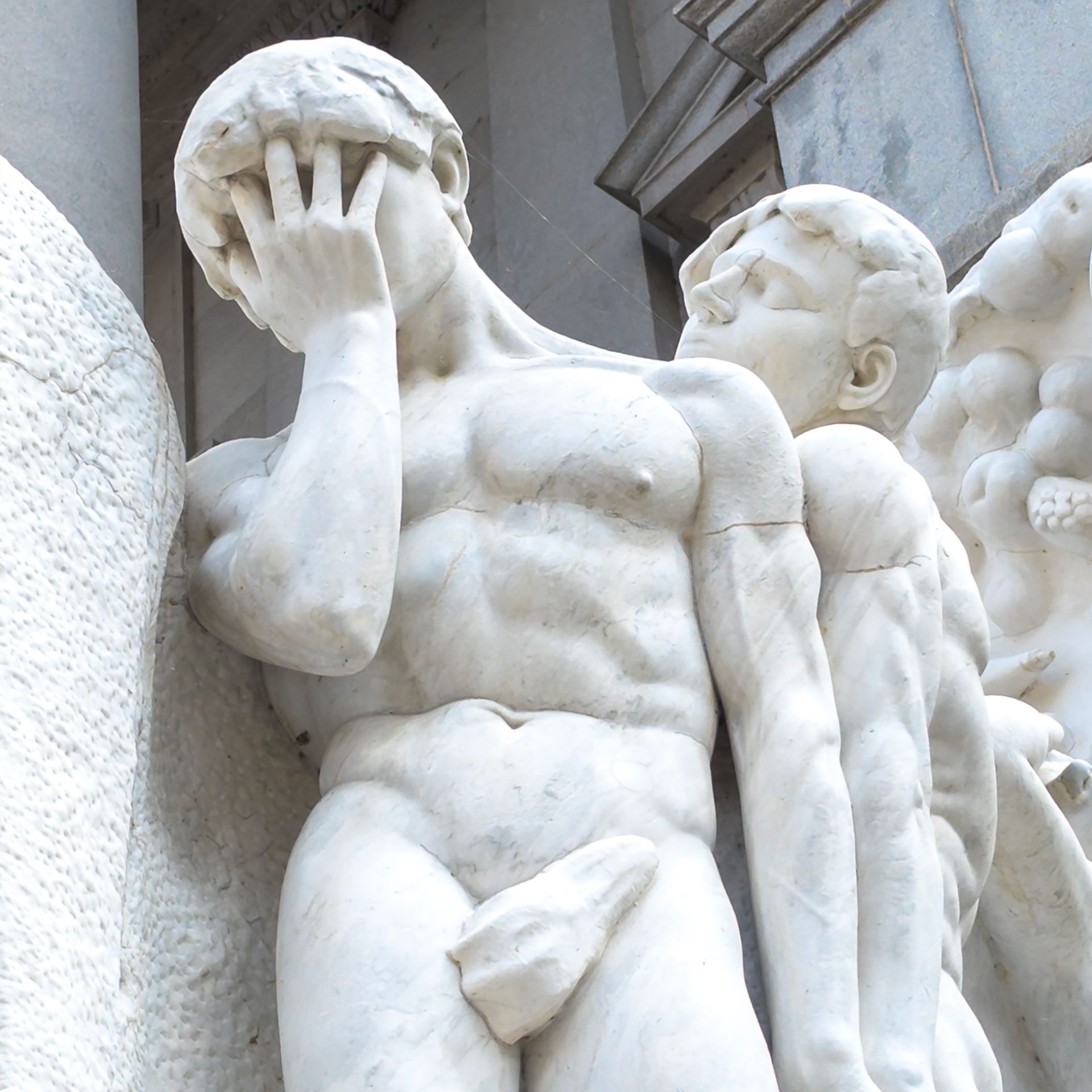
Tales from the Cryptid
on the trail of the Typhonian beast
The ancient Egyptians were stone cold furry freaks and you know it!
Legions of animal-headed gods just yiffing away at the bottom of one big mythological furpile. Jackals on dogs on cats on lions on hawks on crocodiles. Nasty stuff. Freak nasty. Good nasty.
And who can blame them? Who among us has not gazed at the illustration on page 50 of Deities & Demigods and had a strange awakening? Or walked away from a screening of Space Jam with a strange stirring in our loins? A stronger man than I, that’s for sure.
All uncomfortable joking and oversharing aside, there are plenty of good reasons for Egyptian deities to have animal heads. Ancient Egyptian art was highly stylized with very little room to add naturalized details. After all, there are only so many possible variations of a basic human figure, unless you want to develop a series of elaborate and increasingly preposterous hats indicating rank and office. Animal heads are an elegant solution this problem, as they are visually distinctive and act as a shorthand for the attributes of the deities depicted.
Sometimes, it’s they’re obvious. Bast, goddess of cats, has a cat head.
Sometimes, they take a bit more effort. Sobekh, lord of rivers, has the head of a crocodile. Anubis, the psychopomp who deals with the dead, has the head of a carrion-eating jackal.
Sometimes they’re less literal and more symbolic. Savage, warlike Sekhmet has a lion head because lions are fierce. Keen-eyed, relentless Horus has a hawk head because hawks are tenacious hunters. Mysterious, enigmatic Thoth has a ibis head because those things are just weird.
So, keeping that in mind, let me ask you a simple question.
What kind of animal is Set?
Set? Seth? Sutekh? God of deserts, storms, and the night? Son of Geb (the earth) and Nut (the sky)? Husband of Nepthys? Brother of Osiris? Chopped Osiris into tiny pieces and usurped the kingdom of Egypt until he was finally overthrown by his nephew Horus? Has the powers of a 15th-level cleric, 17th-level fighter, 30th-level illusionist and 15th-level assassin? Wields a +4 spear of darkness and can change anyone’s alignment to lawful evil with a touch?
That Set?
What kind of animal is he?
I know you can see it in your mind’s eye. It’s gray, or maybe black, maybe a little reddish. There are prominent, squared-off ears. A long, droopy snout. What is that?
Is it a donkey?
That’s a good guess! The Ancient Greeks certainly thought so, perhaps thanks to a ritual where the priests of Horus at Edfu would symbolically take revenge on Set by dismembering an onager or wild ass. Ancient Greeks, though, aren’t Ancient Egyptians and Egyptian sources don’t identify Set as a donkey. Set also doesn’t have any of the qualities we would traditionally associate with donkeys, either: stubbornness, foolishness, humility. Besides, there are numerous depictions of donkeys and asses in Egyptian art and they don’t look like Set.
Is it a jackal?
Another good guess! He does kind of look like a jackal. Once again, though, there are numerous depictions of jackals in Egyptian art and they always have pointy ears and not the squared off ears that Set has. Besides, there’s already a jackal-headed god, Anubis, and it sort of defeats the point of animal-head-based symbolism if you give two gods with different attributes the same head.
Maybe this would be easier if we understood Set a bit more.
He was one of the oldest gods of Egypt, a key part of the Heliopolitan Ennead. Despite that, he is not a god of Lower Egypt but of Upper Egypt, and really, not there either, not truly. His realm is the desert beyond, lawless, savage and wild. He is not a nice guy and unpleasant to be around — he ripped his way out of his mother Nut’s womb, murdered his brother Osiris, and sexually abused his nephew Horus. (They tend to leave that last one out of the kid-friendly mythology books.) He creates conflict and chaos and natural disasters wherever he goes.
For all that, though, he is an integral part of the pantheon. Each night when the gods sally forth in their barque to do battle with Apep, the sun-devouring serpent, its is Set and Set alone who has the strength to slay the serpent and allow a new day to dawn. Later, when Egyptian mythology starts to mix with the Semitic religions to the east, Set is identified with Baal Hadad and becomes the god who drives back Yam, the insatiable sea, helping to create the land.
Is there an animal that is strong and supremely dangerous but still utterly necessary for the functioning of society? Maybe a bull, I guess, but I think Hathor and Apis have that one locked up.
Wait, in the story where Set murders Osiris he sometimes takes an animal form to do the deed! Usually an ass, or a bull, or a crocodile. When he eats the eye of Horus, he takes the form of a black boar!
Except that doesn’t help either. These stories stress that Set is changing form, which means that his normal form is not that of an ass or a bull or a crocodile. That only tells us what Set isn’t, not what he is.
Okay, this is getting us nowhere. Maybe we should take a closer look at the animal itself.
Fortunately, there are numerous depictions of the whole animal — the “sha” — in Egyptian art and hieroglyphs. We’ve already discussed the head, with its long squared-off ears and droopy snoot. The body is dog-like or wolf-like, but extremely thin, almost like a greyhound. And the tail is utterly distinctive, long and always straight as an arrow with something on the end that could either be a forked tuft like a bird’s or a bristly poof like a wild pig’s depending on how you squint. It’s usually black or gray, but sometimes red.
Doesn’t sound like anything, does it?
Don’t expect an answer to this question today, because this is a problem that has bedeviled Egyptologists for centuries. The sha, Set animal, or Typhonian beast has characteristics that match several different animals but doesn’t match any of them exactly.
Based off of the overall canine appearance of the sha, some scholars have identified it as a dog, either an African wild dog, or a golden jackal, or a hyena, or perhaps a domestic dog breed similar to the saluki but whose distinctive features have been bred out of the line over the centuries. The problem is, there are numerous depictions of dogs in Egyptian art and once again, they don’t look like the sha.
Other scholars, focusing on the prominent squared-off ears, have suggested that it could be a fennec fox or an aardvark. Others, focusing on the bristly tail, have identified it as a wild ass or giraffe. Others have identified it as an antelope, camel, crocodile, gazelle, hare, hippopotamus, jerboa, okapi, onager, oryx, or wild ass. Again, none of these animals quite fit the full appearance or overall vibe.
Some have suggested that the sha might be a fantastic beast created by artists inspired by the skulls of the sivatherium, an extinct variety of short-necked giraffe, whose bony horns may have been misinterpreted as squared-off ears. Sivatherium skulls have been found in temples devoted to Set. As intriguing as this possibility is, though, it seems more likely that the skulls were valued because of their resemblance to the sha rather than serving as an inspiration for the sha.
Other scholars have suggested that the sha was a real animal but hunted to extinction because of its association with Set. Sounds good, except… well, there were temples to Set and priests of Set, weren’t there? You think they’d have something to say about that. Or that we’d have mummified versions, or at least some bones to go off of.
For a while the leading theory was that the sha was actually some sort of feral pig or wild boar. Egyptologist P.E. Newberry based this theory on some solid observations: that the pig was a sacred animal to the Egyptians; that Set sometimes transforms himself into a wild boar; and that are several types of feral and semi-feral pigs that have lean bodies and had erect tails, notably the Old Irish Greyhound Pig. This all seems very promising until you realize that Newberry had never actually seen a feral pig; he’d only read ever descriptions of them in books. If you actually see a feral pig in the flesh, you’d agree that they have lean haunches — but they still have a distinctly porcine body shape. Which the sha does not. It doesn’t even have tusks.
This has led most scholars to throw up their hands and declare that the sha is purely an imaginary animal, or at best a composite creature made from bits and pieces of other animals. If so, it’s the least out-there imaginary animal Ancient Egypt ever dreamed up. Their usual flights of fancy are things like the setcha (a leopard with a snake for a head) or the sak (which had the front part of a lion, the back part of a horse, the head of a hawk, a tail with a lotus flower on the end, and eight teats).
At this point the Set animal will remain a baffling enigma unless we discover some hidden temples, preserved remains, or vast trove of hitherto unknown hieroglyphic writings. That’s okay. I already know everything I need to know about Set.
He has an armor class of -4, 378 hit points, 59% magic resistance and all psionic attack and defense modes.
Preview of Series 10
We’re almost done with our prep work for Series 10, which will take us from down under to the top of the world, and from the cradle of civilization to the ass-end of Florida. As usual, here’s a list of some of the work we consulted in our research.
- A Time to Remember
- Altai-Himalaya
- King Dragon
- Mile Marker Zero
- Mountbatten: A Biography
- The American Backwoods Frontier: An Ethnic and Ecological Interpretation
- The Mirage Factory: Illusion, Imagination, and the Invention of Los Angeles
Photo by tutincommon (cropped from original).
Errata
(All corrections from the errata have been incorporated into this article, but not into the published audio.)
Connections
You may have noticed some D&D content in this episode. If that’s your thing, why not check out “The Die of Tomorrow, Today,” our paean to the 30-sider, or “Grandiose But Straightforward,” about an obscure bit of D&D fanon?
Sources
- Betro, Maria Carmela. Hieroglyphics: The Writings of Ancient Egypt. New York: Abbeville Press, 1995.
- Eberhart, George M. Mysterious Creatures: A Guide to Cryptozoology (Volume Two). Santa Barbara, CA: ABC Clio, 2002.
- Newberry, P.E. “The Pig and the Cult-Animal of Set.” Journal of Egyptian Archaeology, Volume 14, Number 3/4 (November 1928).
- Pinch, Geraldine. Handbook of Egyptian Mythology. Santa Barbara, CA: ABC-CLIO, 2002.
- Wallis Budge, E.A. Gods of the Egyptians. Chicago: Open Court, 1904.
- Ward, James M. and Kunz, Robert J. Deities & Demigods. Lake Geneva, WI: TSR Games, 1980.
- Wilkinson, Richard A. Reading Egyptian Art. London: Thames and Hudson, 1994.
- “Set animal.” Wikipedia. https://en.wikipedia.org/wiki/Set_animal Accessed 5/18/2021.
Categories
Tags
Published
First Published:
Last Edited:


